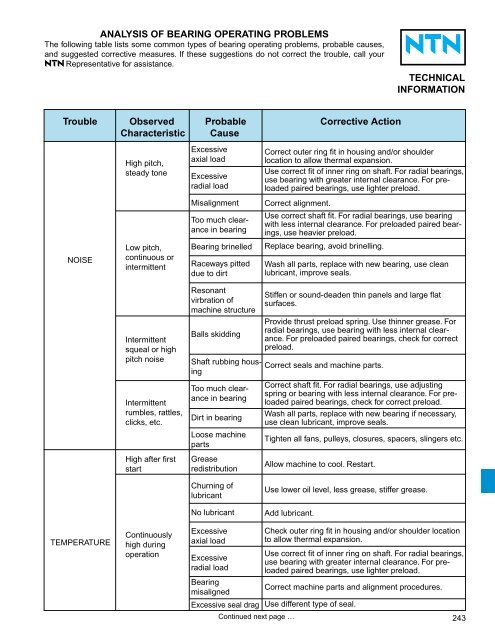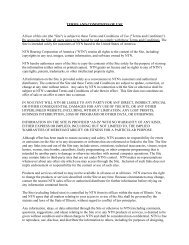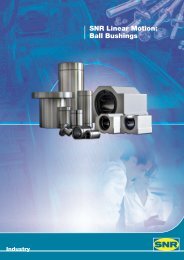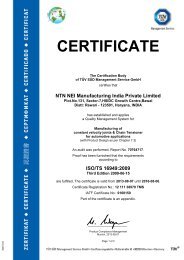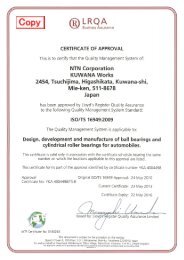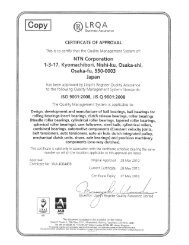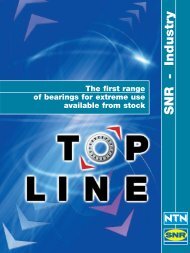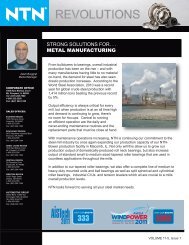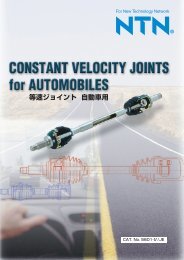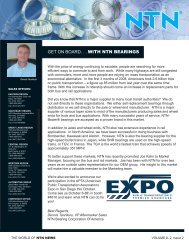ball and roller bearings - NTN Bearing Corporation of
ball and roller bearings - NTN Bearing Corporation of
ball and roller bearings - NTN Bearing Corporation of
Create successful ePaper yourself
Turn your PDF publications into a flip-book with our unique Google optimized e-Paper software.
ANALYSIS OF BEARING OPERATING PROBLEMS<br />
The following table lists some common types <strong>of</strong> bearing operating problems, probable causes,<br />
<strong>and</strong> suggested corrective measures. If these suggestions do not correct the trouble, call your<br />
Representative for assistance.<br />
Trouble Observed Probable Corrective Action<br />
Characteristic Cause<br />
NOISE<br />
TEMPERATURE<br />
High pitch,<br />
steady tone<br />
Low pitch,<br />
continuous or<br />
intermittent<br />
Intermittent<br />
squeal or high<br />
pitch noise<br />
Intermittent<br />
rumbles, rattles,<br />
clicks, etc.<br />
High after first<br />
start<br />
Continuously<br />
high during<br />
operation<br />
Excessive<br />
axial load<br />
Excessive<br />
radial load<br />
Misalignment<br />
Too much clearance<br />
in bearing<br />
<strong>Bearing</strong> brinelled<br />
Raceways pitted<br />
due to dirt<br />
Resonant<br />
virbration <strong>of</strong><br />
machine structure<br />
Balls skidding<br />
Shaft rubbing housing<br />
Too much clearance<br />
in bearing<br />
Dirt in bearing<br />
Loose machine<br />
parts<br />
Grease<br />
redistribution<br />
Churning <strong>of</strong><br />
lubricant<br />
No lubricant<br />
Excessive<br />
axial load<br />
Excessive<br />
radial load<br />
<strong>Bearing</strong><br />
misaligned<br />
Excessive seal drag<br />
Continued next page …<br />
TECHNICAL<br />
INFORMATION<br />
Correct outer ring fit in housing <strong>and</strong>/or shoulder<br />
location to allow thermal expansion.<br />
Use correct fit <strong>of</strong> inner ring on shaft. For radial <strong>bearings</strong>,<br />
use bearing with greater internal clearance. For preloaded<br />
paired <strong>bearings</strong>, use lighter preload.<br />
Correct alignment.<br />
Use correct shaft fit. For radial <strong>bearings</strong>, use bearing<br />
with less internal clearance. For preloaded paired <strong>bearings</strong>,<br />
use heavier preload.<br />
Replace bearing, avoid brinelling.<br />
Wash all parts, replace with new bearing, use clean<br />
lubricant, improve seals.<br />
Stiffen or sound-deaden thin panels <strong>and</strong> large flat<br />
surfaces.<br />
Provide thrust preload spring. Use thinner grease. For<br />
radial <strong>bearings</strong>, use bearing with less internal clearance.<br />
For preloaded paired <strong>bearings</strong>, check for correct<br />
preload.<br />
Correct seals <strong>and</strong> machine parts.<br />
Correct shaft fit. For radial <strong>bearings</strong>, use adjusting<br />
spring or bearing with less internal clearance. For preloaded<br />
paired <strong>bearings</strong>, check for correct preload.<br />
Wash all parts, replace with new bearing if necessary,<br />
use clean lubricant, improve seals.<br />
Tighten all fans, pulleys, closures, spacers, slingers etc.<br />
Allow machine to cool. Restart.<br />
Use lower oil level, less grease, stiffer grease.<br />
Add lubricant.<br />
Check outer ring fit in housing <strong>and</strong>/or shoulder location<br />
to allow thermal expansion.<br />
Use correct fit <strong>of</strong> inner ring on shaft. For radial <strong>bearings</strong>,<br />
use bearing with greater internal clearance. For preloaded<br />
paired <strong>bearings</strong>, use lighter preload.<br />
Correct machine parts <strong>and</strong> alignment procedures.<br />
Use different type <strong>of</strong> seal.<br />
243


